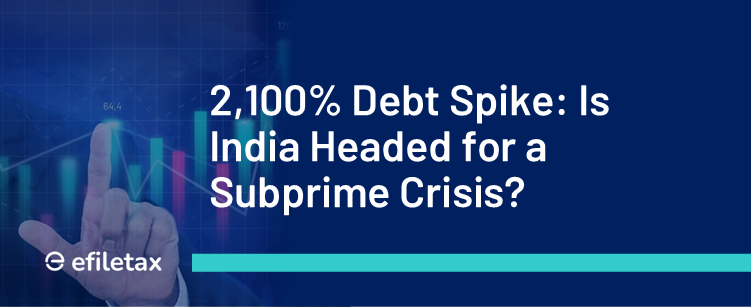
India Debt Crisis: What the 2,100% Subprime Surge Means for You
India’s financial system is facing a brewing storm. The India debt crisis, largely fueled by a 2,100% surge in subprime lending over the past few years, is threatening millions of families with over-indebtedness, job losses, and financial distress.
The growth in unsecured, high-interest loans — mostly targeting rural and low-income households — has triggered red flags across the Reserve Bank of India (RBI), policymakers, and economists alike.
📉 What is Subprime Lending & Why It’s Risky
Subprime loans are high-risk loans issued to individuals with weak credit profiles or limited repayment capacity. While they promote financial inclusion, they come with higher interest rates and looser credit checks.
❗ Key Risks of Subprime Lending:
- Minimal due diligence or collateral
- High default probability
- Debt rollover: Borrowers take one loan to repay another
- Psychological and social toll on families
In India, microfinance institutions (MFIs), NBFCs, and fintech platforms have aggressively pushed such loans—often without adequate borrower assessment.
🔎 RBI’s Position and Legal Framework
In response to the growing risks, the Reserve Bank of India has flagged rising Non-Performing Assets (NPAs) in the unsecured personal loan segment. RBI’s regulatory framework under the NBFC Prudential Norms Directions, 2021 and recent supervisory guidelines urge:
- Cap on exposure to unsecured lending
- Periodic stress testing for NBFC portfolios
- Mandated risk disclosures for borrowers
Notable Precedent:
In the case of DHFL (Dewan Housing Finance Corporation Ltd), the RBI invoked Section 45-IE of the RBI Act, 1934 to supersede its board after defaulting on public deposits, highlighting how mismanagement in the credit sector can lead to legal and economic fallout.
📊 Real-World Impact on Indian Families
Based on industry surveys and internal MFI data:
- Over 68% of subprime borrowers are under financial stress.
- Around 27% borrow new loans to repay old ones.
- School dropouts and distress migration are increasing in debt-heavy districts.
✅ What Can Be Done?
For Borrowers:
- Understand repayment terms before borrowing
- Avoid rolling over loans
- Seek help from certified credit counselors
For Regulators:
- Mandate credit education at the onboarding stage
- Monitor digital lending apps for predatory practices
- Build a central registry for unsecured loans
For Financial Institutions:
- Use AI/ML credit scoring to assess risk better
- Offer restructuring options for stressed borrowers
- Promote ethical recovery practices
💡 Key Takeaways for Businesses & Professionals
- Fintechs and NBFCs must implement better credit risk protocols and ethical lending guidelines.
- Startups and MSMEs dependent on NBFCs must monitor borrowing exposure.
- Legal professionals may see a rise in insolvency cases related to personal loan defaults.
- Tax consultants should advise clients on maintaining a healthy credit profile to avoid debt-related disruptions in financial planning.